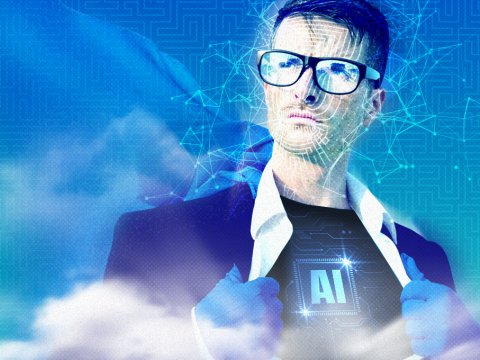Why You Should Make Sustainability a CIO Superpower
Sustainable IT should be a high priority for CIOs. See why they possess the power to adopt sustainable standards, collaborate with industry peers and help pave the way toward a stronger, healthier future.
Action movies are packed with characters who have hit the superpower jackpot. These imaginative figures have superhuman abilities — the power to fly, move mountains, transform into any creature, read minds or even cheat death. Today, CIOs have superhuman powers, too. In particular, they have sustainability superpowers — if they choose to use them. But what does that mean?
Sustainability as a CIO superpower refers to the ability CIOs possess to advance environmental, economic and equitable sustainability activities within their organizations. Among the members of the C-suite, they are uniquely positioned to leverage technology and data to “drive development that meets the needs of the present without compromising the ability of future generations to meet their own needs." (Source: The United Nations World Commission on Environment and Development)
Sustainability as a CIO superpower also means taking advantage of the ability to lead in the long term versus simply focusing on profitability today. And it means demonstrating a commitment to corporate values through ethical behaviors that focus on creating a safe and successful environment where people, the environment and economies can thrive.
Beyond technology — Leadership shapeshifting
In the past, CIOs were focused like a laser beam on improving organizational IT efficiencies. Their goal was to optimize IT resources in ways that could help achieve business goals. In the past, sustainability was a value managed by a variety of departments within an organization, such as facilities management, dining services or human resources. But today both the role of the CIO and corporations’ sustainability goals are viewed from a completely different perspective than these outdated perspectives.
Sustainability has become a critical demand across industries. Now, organizations have to prove to the world that they are taking significant action on several fronts, including reducing emissions and waste, decreasing their carbon footprint, aiming to achieve net zero goals and practicing inclusiveness.
At the same time, the role of CIOs has shifted from strictly keeping IT running to having the power to create lasting business value — including through a meaningful sustainability program. Responsibilities under their evolved leadership role include tasks such as establishing environmental stewardship, building efficient systems of checks and balances, and promoting workplace diversity in technology.
Taking a responsible role in sustainability means moving beyond a limited definition of sustainability focused only on environment. We must now adopt a truly holistic approach that addresses organizations’ high-level goals at the intersection of the environment (make IT green), workplace equality (make IT accessible) and economics (make IT viable).
And this is where the CIO is critical. To achieve these goals, organizations need visionary leaders to take the reins and steer their companies in a holistic manner that adds tremendous value on all three levels, as depicted in the graphic below.
The AI-sustainability paradigm
A great example is the mass adoption of AI that is unfolding right now. When discussing technology’s newest addition, we are facing significant questions for which we must have satisfactory answers.
When it comes to AI, there are many opportunities, but also many concerns around issues of ethics and privacy, for example. Organizations need clear processes and rules in place on how to use the leading-edge technology in responsible and ethical ways. This requires establishing guardrails against biases, privacy issues and regulatory noncompliance.
Like insurance agents who view their business through a risk-based lens, in our modern world, CIOs need to put on their "sustainability glasses,” so they can view these serious issues according to their impact on the environment, the business and society at large. This is the way to use their C-level superpowers to build stronger organizations that are sustainable in the long term.
How can you make a big impact?
To achieve sustainability goals, sustainable IT should be part of every CIO's focus every day. A cloud first approach to technology powered by renewable energy should be on every CIO’s agenda. When building cloud workloads, the practice of sustainability is understanding the impacts of the services used, quantifying impacts through the entire workload lifecycle and applying design principles and best practices to reduce these impacts. Among the hyperscalers, Amazon Web Services (AWS) has positioned itself as a sustainability leader, pledging to reach net-zero carbon emissions by 2040 and to power its operations with 100% renewable energy by 2025. AWS’s sustainability pillar focuses on environmental impacts, especially energy consumption and efficiency, since they are important levers for architects to inform direct action to reduce resource usage. This pillar can be operationalized by practicing six AWS design principles for sustainability in the cloud:
- Understand your impact
- Establish sustainability goals
- Maximize utilization
- Anticipate and adopt new, more efficient hardware and software offerings
- Use managed services
- Reduce the downstream impact of your cloud workloads
Additionally, to support this objective, CIOs can get plugged into leading organizations, such as SustainableIT.org. It is a 501(c)(6) non-profit organization, that advances global sustainability through technology leadership.
In the organization, technology executives come together to help define sustainability transformation programs, author best practices and frameworks, set standards and certifications, educate and train other leaders, and raise environmental and societal awareness on how to create a sustainable world that will last for generations.
The organization publishes the IT Standards for Environmental, Social, and Governance Sustainability. This document provides a framework that IT leaders can use to jumpstart the development of a strong sustainability program in their organizations. It includes metrics, indicators and a tiered system designed to meet different transformational goals (as shown in the three graphics below).
SustainableIT.org has done the groundwork so CIOs can quickly launch and uplevel a sustainability initiative. By taking action and measuring activity according to the guidelines, CIOs can reinforce behavior and ensure adherence to the values in all three areas — environmental, social and economic.
Tier 1 first-priority goals in IT
To date, SustainableIT.org has compiled over 200 IT-tailored ESG standards representing a cross-industry set of topics and metrics for measuring, tracking and reporting technology’s ESG impact, including impact data and models. The Tier 1 IT standards (listed below) guide IT leaders through the process of planning and executing standards within their own organizations.
Environmental impact Tier 1 standards include:
- Prefer Energy Star-certified hardware
- Provide SaaS and cloud-hosted IT services
- Use 100% renewable energy
- Fully automate IT services
- Measure and track technology GHG
- Create carbon-neutral technology infrastructure
- Use low-impact data center cooling (on-premises and hosted)
- Digitize documents
- Implement circular device lifecycles
- Obtain sustainability-certified technology vendors
- Implement carbon-neutral technology procurement
- Source 100% sustainability-sourced IT services
Social impact Tier 1 standards include:
- Ensure user inclusiveness is measured and tracked for diverse populations
- Robustly adopt assistive technology
- Exceed industry and regional averages in IT staff diversity
- Vet tech and enterprise vendors for human rights practices
- Identify potential health and safety impacts of IT
Governance impact Tier 1 standards include:
- Put sustainability, governance, and accountability in place
- Ensure adequate funding is in place and embedded in relevant budgets
- Provide sustainability training
- Regularly review and assess data security policies
- Allow data owners to have control and visibility over how their data is used
- Conduct data lifecycle management sustainably
- Incorporate ESG risks
- Keep business continuity plans up to date
- Implement financial fraud and corruption safeguards
- Develop innovations and AI sustainably
- Develop a future of work strategy
What we’re doing at Rackspace Technology
Rackspace Technology® is demonstrating the importance of investing in people and technology to achieve sustainable business practices through collaborations with suppliers, the creation of innovative employee training programs and the embrace of ESG principles.
Our company is taking action to combat data sprawl to reduce carbon emissions and focusing on the economic and social sustainability of data management plans. We are committed to achieving net zero carbon emissions by 2045 and have already implemented smart building automation systems to manage light, heat and cooling, as well as collecting information about greenhouse gas emissions.
I am excited to continue serving as the convener of the Central Ohio CIO Forum (170+ VP/CIOs),where collaboration among CIOs helps drive community sustainability. Here, in Ohio, we have already kicked off a working group consisting of 25+ companies. Meeting regularly, the group has begun using the SustainableIT.org framework and turning it into meaningful action and impact throughout their organizations.
Our technology leaders are jointly reducing the climate impacts of their hardware and software, including rethinking hiring and training practices and upcycling old devices. Working together, the group is designing systems that are economically viable and equitable.
Our work group applies sustainability principles in the field and seeks ways to help others understand and adopt sustainability tactics. For example, the Columbus-based digital insurer, Branch Insurance, exists entirely in the cloud. It hires junior developers in a bootcamp program that has helped the company create a cohesive team of engineers through its in-house coding classroom. Nearly half of Branch Insurance's programmers enter the field as a second career via a six-month internship, with about half of the students joining the company in full-time positions. Their average age is 28.
In July 2023, my colleague, Srini Koushik, who is Chief Technology Officer at Rackspace Technology, was recognized with the SustainableIT Impact Award for Social Impact. It honors technology leaders for their commitment to ESG sustainability and for inspiring other C-suite partners to act toward positive change. Srini also serves as board member for Sustainableit.org. Congratulations, Srini!
Advancing sustainability through technology leadership
Sustainable IT practices are essential for the future success of businesses and the environment. CIOs, along with their peers, possess the power and must recognize the responsibility to embrace the principles of sustainable IT and take the necessary steps to help create an equitable, healthier and more sustainable future.
As they say, with great power comes great responsibility. Working in technology brings great privilege, but technology needs to start playing a much bigger role. Using sustainability as a superpower, CIOs can step up and work toward IT that is sustainable for the environment, society and organizational economics.
Together, let’s take immediate action to leverage technology to transform our businesses, the economy and the world for the better. Join us at SustainableIT.org. Become part of the movement to create strategic sustainability initiatives with the superpower of today’s technology leaders.

Balancing Ethics, Equity and Sustainability to Achieve Responsible AI
About the Authors

VP - Technology and Sustainability
Ben Blanquera
Ben Blanquera is the VP of Technology and Sustainability at Rackspace Technology. He partners with enterprises to architect solutions that drive business outcomes, enabling them to thrive. In addition to his work in cloud and AI, Ben leads initiatives on sustainability, helping Rackspace and their customers navigate the intersection of technology and environmental responsibility. He focuses on reducing carbon footprints, and leveraging AI to advance sustainable practices across industries. He is a 35-year veteran in multiple industries including health care, manufacturing, and technology consulting. Prior to Rackspace, Ben was with Covail, a leading-edge provider of AI/ML and cybersecurity services to Fortune 1000 clients. At Covail, Ben was VP of Delivery and transitioned to VP of Revenue and Client Success. A recognized technology leader, Ben was named a Premier 100 leader by Computerworld. Outside of work, he loves to travel, ride his bike, and spend time with his wife and four daughters. He is an active organizer in the tech community and curates the Central Ohio CIO forum (150+ CIOs) and founded Techlife Columbus. Ben also serves on the Pitch Advisory Board for South by Southwest and the Editorial Board for CDO Magazine.
Read more about Ben BlanqueraRelated Topics




